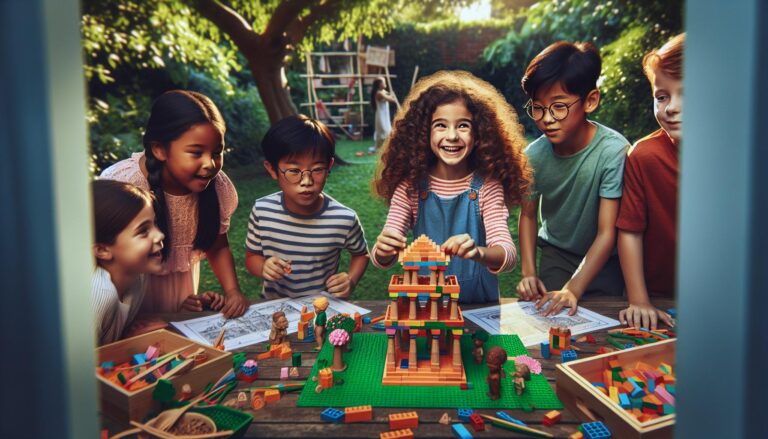
Key Takeaways
- Interactive activities make history engaging and memorable by transforming lessons into hands-on, immersive experiences that connect children to the past.
- Encourage engagement and creativity through role-playing, crafting historical artifacts, and designing projects that spark curiosity and critical thinking.
- Adapt to different learning styles with methods like storytelling, reenactments, timelines, and virtual tours to cater to visual, auditory, and kinesthetic learners.
- Incorporate tools and resources like online platforms, books, and activity guides to enhance lessons and foster hands-on connections to historical themes.
- Leverage family involvement and local groups to create collaborative and enriching educational experiences that bring history to life.
- Thematic and multimedia-based learning organizes topics in fun and comprehensive ways, helping children explore history deeply and enjoyably.
Teaching history at home can feel overwhelming—how do we make the past come alive for our kids? We all want lessons that spark curiosity and help them truly connect with the stories that shaped our world. But let’s be honest, keeping history engaging while covering essential topics can be a challenge.
That’s where interactive activities come in. By turning lessons into hands-on experiences, we can transform dates and events into vivid, memorable moments. What if our kids could build ancient structures, reenact historical events, or explore timelines in creative ways? These activities don’t just teach—they inspire.
So, how do we create a learning environment that’s both fun and meaningful? Let’s explore ideas that bring history to life, making it a subject our kids will love and remember.
Benefits Of Interactive History Homeschool Activities
Interactive history activities bring learning to life, making lessons exciting and memorable. They create an immersive experience that helps children connect with the past in meaningful ways.
Encourages Engagement And Retention
Hands-on activities capture children’s attention and make history lessons more enjoyable. Reenacting historical events, crafting period artifacts, or exploring maps encourages active participation. When children engage directly, they are more likely to remember key details and concepts. How do your children respond to learning when they experience it firsthand?
Sparks Creativity And Curiosity
Creative tasks invite children to imagine and explore different perspectives. Designing historical costumes, inventing hypothetical diary entries, or building replicas of ancient structures inspires curiosity and critical thinking. What if children could step into the shoes of historical figures? Such activities spark questions that motivate deeper exploration.
Adapts To Different Learning Styles
Interactive methods suit visual, auditory, and kinesthetic learners. For instance, visual learners benefit from timelines or diorama projects, while auditory learners thrive on storytelling or group discussions. Movement-based activities, like reenactments, cater to physical learners. How can including varied approaches make history more accessible for your child?
Types Of Interactive History Homeschool Activities

Interactive activities transform history lessons into experiences that resonate with children. Let’s explore different methods that make history education exciting and engaging.
Hands-On Projects And Crafts
Creating tangible items helps children connect with historical contexts. Building models of famous landmarks, such as the Pyramids of Giza or medieval castles, allows them to visualize and understand architectural achievements. Designing period-specific clothing or tools provides a deeper appreciation of everyday life in different eras. These projects encourage creativity while reinforcing historical knowledge.
Role-Playing And Simulations
Reenacting historical events immerses kids in pivotal moments from the past. Acting out the signing of the Declaration of Independence or participating in a mock battle from the Civil War lets them experience history actively. Through simulations, like forming a parliamentary debate, children gain insight into historical decision-making processes and its impact on societies.
Virtual Field Trips
Virtual tours bring far-off historical sites to life. Platforms showcasing landmarks like the Colosseum or the Great Wall of China make history accessible without leaving home. These digital tools provide detailed visuals and stories, guiding children through centuries of cultural development. Incorporating virtual experiences enriches lessons with global perspectives.
Storytelling And Historical Debates
Hearing or narrating stories humanizes historical figures and events. Sharing personal accounts, like diary entries from the Revolutionary War, helps students relate emotionally to historical struggles and triumphs. Debating key events, such as the causes of World War I, develops critical thinking and an understanding of differing viewpoints. These discussions foster analytical skills and intellectual growth.
How To Incorporate Interactive Activities Into History Lessons

Interactive activities enrich history lessons by making them engaging and fostering deeper connections to the past. They encourage curiosity and allow children to actively participate in their learning process.
Planning Thematic Units
Organize lessons around specific historical periods, figures, or events. For example, dedicate a week to Ancient Egypt by exploring its culture, creating pyramid models, and learning about mummification through DIY activities. Structured thematic units focus attention on key details and connect related concepts across multiple lessons. How can you align these themes with your child’s interests to make learning more meaningful?
Using Multimedia Tools
Leverage videos, virtual museums, and online simulations to bring historical narratives to life. Watch documentaries that detail significant eras, or tour famous landmarks via virtual reality tools for immersive exploration. Interactive maps and history apps also provide opportunities to examine historical geography. Incorporating multimedia adds depth to lessons while catering to visual and auditory learners.
Involving The Whole Family
Turn learning into a shared experience. Host family debates about historical events or create simple group projects like building a miniature Fort Sumter or crafting a medieval castle. Assign roles for reenactments, allowing everyone to participate in retelling history. Shared activities make history lessons collaborative, creating lasting memories. How can your family engage in history together for both fun and learning at home?
Recommended Resources For Interactive History Activities
Finding quality resources is vital for creating engaging, interactive history lessons. We’ve compiled key tools and ideas to make history engaging and accessible from various perspectives.
Online Platforms And Apps
Online tools bring history alive with dynamic features. Interactive maps allow children to explore historical events by location, while timelines visually connect key milestones. Apps offering quizzes, virtual simulations, and augmented reality tours provide exciting, hands-on learning opportunities. For example, platforms with 3D reconstructions of ancient sites or interactive battles give children immersive ways to grasp historical events.
Does your child enjoy visuals or prefer interactive tasks? Online resources cater to many interests and learning styles, making history more relatable.
Books And Activity Guides
Activity guides and historical books inspire creative projects. Guides that include step-by-step instructions for crafts, recipes, or building models let children engage deeply with historical themes. Biographies simplify complex events through personal stories, offering young readers relatable entry points into history.
Do you use books to spark interest in historical facts? Combining reading with activities gives lessons both depth and a hands-on approach.
Community Programs And Groups
Local history programs and homeschool groups are excellent for collaboration. Many museums, libraries, and historical societies host workshops, reenactments, and hands-on history days. These create opportunities for children to connect with peers while learning from experts. Joining groups allows for sharing resources and forming meaningful connections.
Are there community events in your area that offer hands-on historical experiences? Participating in these can make learning both fun and memorable.
Conclusion
Interactive history activities transform homeschooling into an exciting journey through time. By combining creativity, hands-on projects, and immersive experiences, we can make history lessons both meaningful and unforgettable. These methods not only spark curiosity but also encourage critical thinking and deeper connections with the past.
With the right resources and a bit of imagination, we can create a dynamic learning environment that caters to every child’s unique style. Let’s embrace these tools and approaches to inspire a lifelong love for history in our children.
Frequently Asked Questions
1. Why is interactive learning important for teaching history at home?
Interactive learning makes history engaging and memorable by involving children in hands-on activities, role-playing, and simulations. It encourages curiosity, critical thinking, and better retention by allowing them to actively explore historical events and perspectives.
2. What are some examples of interactive history activities?
Examples include building models of landmarks, creating historical costumes, reenacting significant events, storytelling, participating in historical debates, virtual field trips to historical sites, and using augmented reality tools for immersive learning.
3. How can I adapt history lessons to my child’s learning style?
By incorporating a mix of hands-on projects, multimedia tools (like videos and simulations), and collaborative family activities, you can cater to visual, auditory, and kinesthetic learners effectively.
4. What tools or resources can help make history lessons more engaging?
Use online platforms with interactive maps, timelines, and quizzes, as well as books, activity guides, augmented reality apps, and virtual museum tours. Local community programs and homeschool groups also offer great collaborative opportunities.
5. How do thematic units improve history teaching?
Focusing on specific periods or figures through thematic units provides a structured approach to learning. It helps children build a deeper understanding of historical contexts and connect the events more meaningfully.
6. Why are family collaborations important in homeschooling history?
Collaborative projects and discussions bring the whole family together, making history lessons more enjoyable. They create shared experiences, spark curiosity, and leave lasting memories for everyone involved.
7. What are the benefits of storytelling in teaching history?
Storytelling humanizes historical events and figures, helping children build emotional connections. It sparks imagination and critical thinking by presenting history in a narrative format that feels relatable and engaging.
8. Can virtual field trips substitute traditional field trips for history lessons?
Yes, virtual field trips allow children to explore historical sites from home, offering rich visuals, narratives, and engaging experiences that rival or even complement physical trips.
9. How does role-playing enhance history education?
Role-playing makes history come alive by letting children reenact events or embody historical figures. This immersive method fosters empathy, critical thinking, and a deeper understanding of past experiences.
10. How do interactive activities improve retention in children?
Interactive activities engage multiple senses, enhancing focus and comprehension. By actively participating in the learning process, children are more likely to retain information and form meaningful connections to history.

